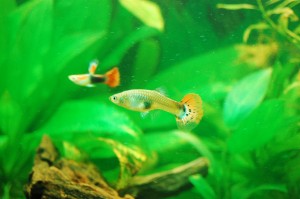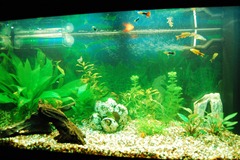Find below some images of our guppy fish (Poecilia reticulata). We have about 10 of them and from these pictures you can see how they the male guppy chase the female ones. Maybe they are just part of every aquarium out there, but I still like them. They are beautiful to look at and really fun to watch at since they are very active and swim all around the tank.
The secret to good plant growth?
In my opinion the plants in a freshwater aquarium is equally important to the fish. The plants make the aquarium look alive and more natural. It also of course fills the void in in the tank and give shelter to the fish. I want tank to have many plants and them to grow well so we try to do everything we can do ensure good plant growth. I don’t say the plants in our aquarium are in bad shape, but since I try to focus on them very much, I think they could look better. Some of the plants are from the old tank, but since it was a lot smaller than the current one, we had to buy new plants. Read more »
Water change confusion – using tap water
I wrote earlier about the different instructions I’ve heard regarding water changes in the fresh water aquarium. I’ll continue this by writing about usage of regular tap water when doing the water changes.
Using tap water in your freshwater aquarium is ok if you use water conditioner for example Tetra AquaSafe. I’ve used this from the beginning and every time for every 10 liters I put into the aquarium. This is common knowledge and I guess there shouldn’t be other opinions about this either.
But I’ve heard different variants on how to add tap water to the aquarium. When I do my water changes, I just turn the tap to cold (the coldest water I can get) and fill a 10 liters bucket with it while adding the water conditioner into it. In Finland the winters can be pretty cold so during winter time I add boiling water from a water boiler (not the hot water from the tap!) to the bucket in order to make it warmer. But I don’t usually do this during the summer. If changing like 20% of the water in the tank, adding cold water to it shouldn’t affect the temperature too much. And it will even out pretty soon anyway. I usually make sure I don’t pour the cold water in too fast and directly on some fish. This is how I have done it for all the past six year. Is this ok?
What Mr. Varjo says in his book is a bit different to this. He says the water should be room temperature and it should sit for some hours before pouring it in so that gases can evaporate from the tap water. I’ve never done this and also the local aquarium shop keeper has not told me to do it like this. Where could I store 30 to 40 liters of water for some hours before pouring it in, and how would I do that? So my question would be, how important is this procedure to let the water rest before pouring it in? And does it matter if the water is room temperature or tap water cold when you pour it in? I haven’t noticed any negative behavior from the fish after the water changes and they seem happy every time to get fresh water.
So I am again a bit confused.
Feeding fish – too little is perfect
I saw this web site my accident: http://www.freshwateraquariumcenteronline.com/freshwater-aquarium-maintenance/. It is run by a professional and the web site says that you can feed your fish up t0 2 or 3 times a day if you follow the rule of thumb that you give them as much food as they can eat in 3-5 minutes. I find this disturbing. Overfeeding is one of the main causes of fish death and non-working aquariums. And to me giving food 2-3 times a day is clearly over feeding. The guy running the site calls himself a professional, but that kind of advice is pure wrong in my opinion.
I feed my fish once a day – maximum. I give them enough food in the morning which they can eat in about 1 minute. Fish have very slow metabolism and they can endure a week without food. While I don’t encourage you to keep your fish without food for a week all the time, it tells me that giving good 2-3 times a day is just too much. This makes your water cloudy and leave you probably very fast with high levels of nitrates since the filtering system cannot take all the excess food and fish urine as a result of too much feeding. The website talks about vacuuming excess food from the bottom of the tank if the fish don’t eat all the food you give them. While I totally agree with this, I have never had the need to vacuum the bottom of my tank just because my fish couldn’t eat all the food. I believe this tells a bit of the statement he gives and that it is wrong. It is only by grave mistake you need to vacuum excess food from your aquarium.
So please bare in mind the simple rule when feeding your fish; too little food is better than too much. Always.
Water change confusion
As long as I had my aquarium I’ve heard all kinds of advice on how to do water changes and how often. Partly this is probably because the need for a water change depends on the aquarium as a whole; how big it is, how many and what kind of fish you have, how many plants you have and how often you feed the fish – and so on. But I think there has to be some general rules that applies to all aquariums in general and that needs to be tweaked depending on the tank in question. My wife was worried about me and the aquarium, so she recently bought a general book on aquarium treatment in Finnish (“Akvaarion perusopas“). The author, Markku Varjo, is considered as one of the experts in Finland regarding freshwater aquariums so what he says in the book should probably be considered as general facts. How does it compare to how I’ve done my water changes? Read more »
Read more »




